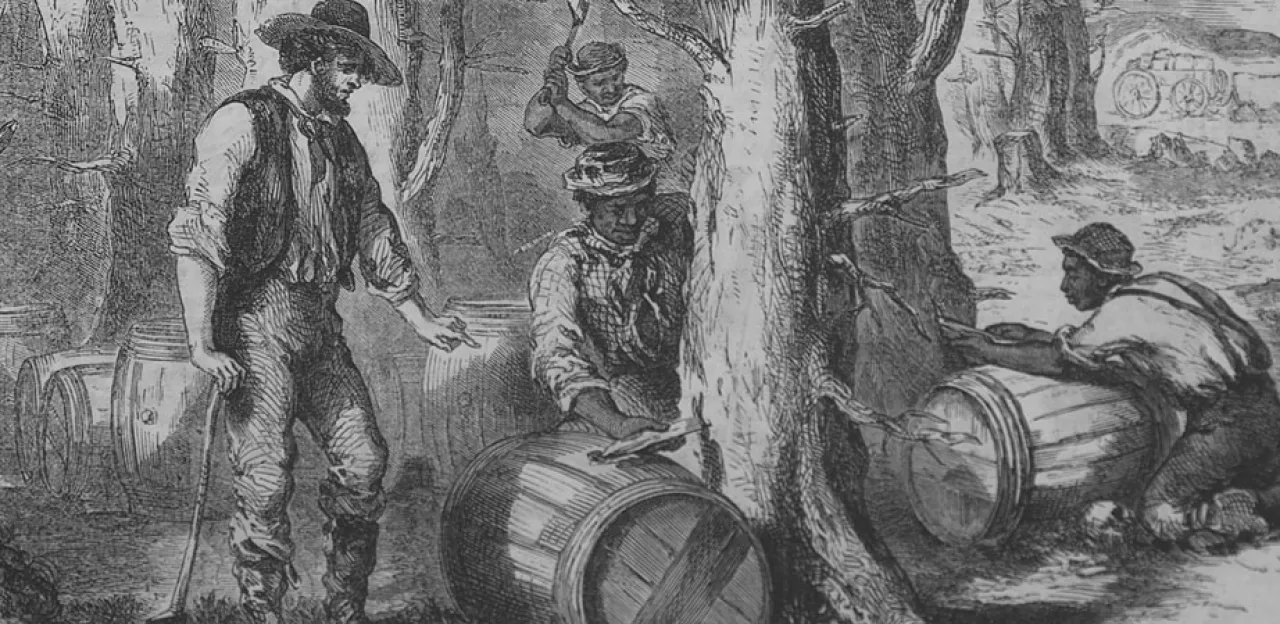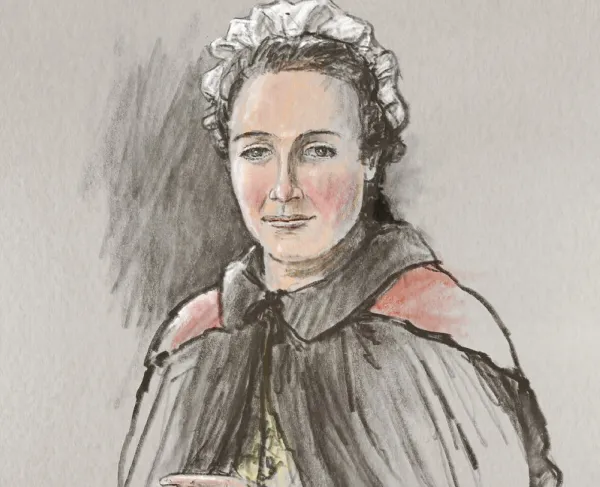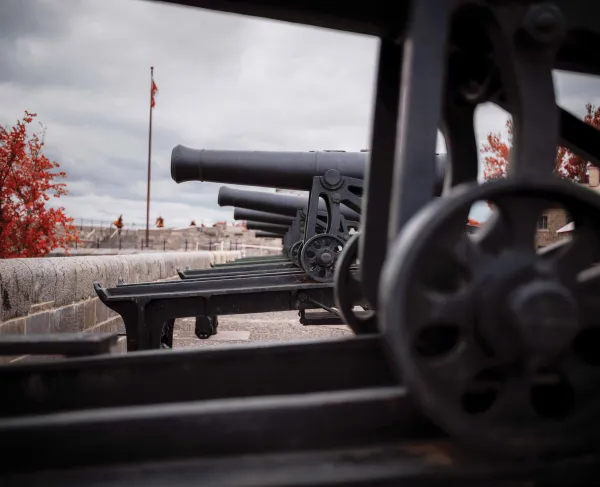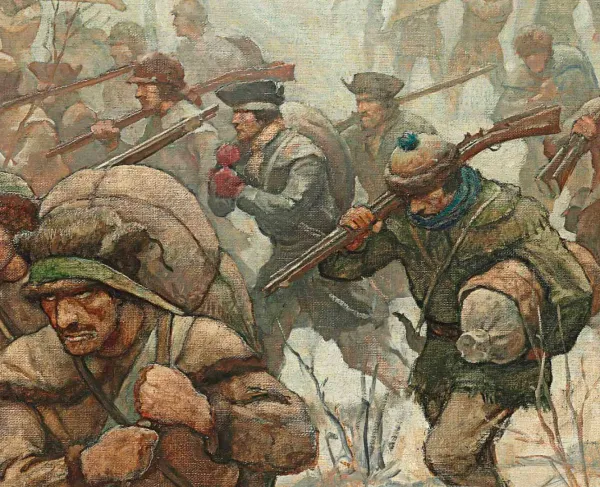Slavery in Colonial America
Many cultures practiced some version of the institution of slavery in the ancient and modern world, most commonly involving enemy captives or prisoners of war. Slavery and forced labor began in colonial America almost as soon as the English arrived and established a permanent settlement at Jamestown in 1607. Colonist George Percy wrote that the English held an “Indian guide” named Kempes in “hande locke” during the First Anglo-Powhatan War in 1610. English colonists exploited Virginia Indians—especially Indian children—for much of the first half of the 17th century. Some colonists largely ignored Virginia laws prohibiting the enslavement of Indian children, which the Virginia Assembly passed in the 1650s and again in 1670.
While colonists continued to enslave Virginia Indians, the first unfree Africans arrived in Virginia in 1619. In that year, colonist John Rolfe wrote to Sir Edwin Sandys, one of the founders of the Virginia Company and its then-treasurer, of the arrival of the first Africans on Virginia’s shores. According to Rolfe, in late August a 160-ton man-of-war, the White Lion, brought “20 and odd Negroes” to Point Comfort (present-day Hampton, Virginia). Governor George Yeardley and merchant Abraham Piersey purchased them in exchange for victuals and supplies. Days later in September, two or three more Africans disembarked from the ship Treasurer. These Africans were likely from the Angolan kingdom of Ndongo, captured by Angolan warriors allied with the Portuguese.
The 1620 census of Virginia records 32 Africans living in Virginia, 17 women and 15 men, listed as “in service of the English” and “in ye service of several[sic] planters.” This census also lists four Indians laboring in the service of English planters. A 1624 muster of the inhabitants of Virginia lists some of the Africans by name, including a woman named Angelo, listed as having arrived on the Treasurer. The legal status of these first Africans in Virginia is unclear—whether the English settlers in Virginia intended to enslave the Africans for life, or whether they served for a period of years before gaining their freedom (a system of indentured servitude) is unknown, though some of these early Africans did later become free. For example, Anthony Johnson (whom the 1625 census lists as “Antonio the Negro”) gained his freedom and by 1640 lived in a community of other free Africans and African Americans in Northampton County, Virginia. Anthony himself may have even enslaved an African man named John Casar.
As Europeans continued to settle the North American colonies throughout the 17th century, the legal codification of race-based slavery also continued to grow. Though many historians agree that slavery and indentured servitude coexisted in the early part of the century (with many Europeans arriving in the colonies under indentures), especially throughout the 1640s-1660s colonies increasingly established laws limiting the rights of Africans and African-Americans and solidifying the institution of slavery upon the basis of race and heredity. In Virginia in 1641, officials sentenced “a negro named John Punch” to serve his master “for the time of his natural life,” after Punch attempted to run away with two European indentured servants. Officials sentenced the two Europeans with four-year extensions on their servitude, while Punch’s punishment was life-long servitude. Many historians look to the case of John Punch as the first instance of legally codified, life-long, and race-based slavery. In New England, colonists continued the practice of enslaving indigenous Indians, particularly those captured during warfare, while also legally justifying the enslavement of African and African Americans. Massachusetts is widely regarded as passing the first law to legalize slavery in 1641, sanctioning slavery for “captives taken in just warres…and strangers as willingly selle[sic] themselves or are sold to us.”
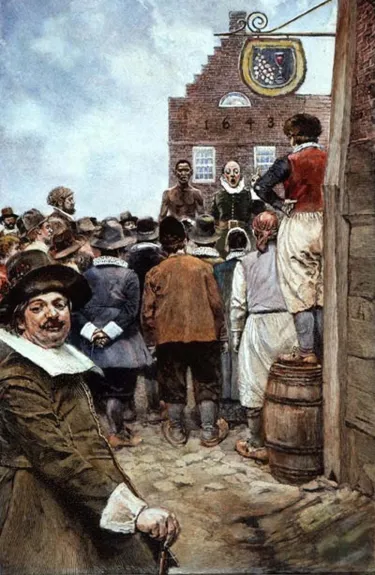
The “triangle trade” largely defines the economics of slavery in the colonial era. In this cyclical system, slave traders imported enslaved Africans to North American colonies. Colonists in turn exported raw goods like lumber, tobacco, and sugar to Great Britain, where those materials were transformed into the finished, luxury goods like rum and textiles that merchants sold or traded along the African coast for enslaved Africans to be sent to North American colonies. Slave traders violently captured Africans and loaded them onto slave ships, where for months these individuals endured the “Middle Passage”—the crossing of the Atlantic from Africa to the North American colonies or West Indies. Many Africans did not survive the journey.
The 1660s was a watershed decade for slavery in colonial America. It is important to remember that during the colonial period, each colony enacted and enforced laws regarding slavery individually. Virginia’s 1662 law establishing that children born to an enslaved mother would also be enslaved further codified race-based and hereditary enslavement in that colony. Maryland legalized slavery in 1663; New York and New Jersey followed in 1664. In addition, that year Maryland, New York, New Jersey, North Carolina, South Carolina, and Virginia passed laws legalizing life-long servitude. Colonies also adopted laws prohibiting non-whites from owning firearms, and established laws that negated a person’s conversion to Christianity from affecting their status as a slave.
It is in this context of the evolution of slavery in colonial America that in 1688 Quakers in Germantown, Pennsylvania presented the first petition against the institution of slavery. The petition argued that slavery violated basic human rights-based upon the Biblical Golden Rule, “do unto others as you would have done unto you.” The petition was neither adopted nor rejected, and largely forgotten until the 19th century.
Many factors contributed to the growth of slavery and the slave trade from the end of the 17th-century through the 18th century. The history and growth of slavery in colonial America was tied to the rise of land cultivation, and particularly the boom in the production of tobacco (in Virginia and Maryland) and rice (in the Carolinas). The Royal African Company’s expansion in 1672 resulted in a growing surge of the transport of Africans to the colonies. When the RAC lost its monopoly in 1696, trade in captive Africans and their transport to the colonies increased further. As the numbers of enslaved Africans rose in the colonies, the practice of enslaving indigenous Indians decreased, and colonial officials further restricted the rights and movements of enslaved Africans and African Americans, including making it harder—even illegal—for slaves to be emancipated. In the first decades of the 18th century, some colonies began prohibiting the importation of enslaved Africans, though the internal slave trade—the buying and selling of enslaved people already in the colonies—increased.
Enslaved people were regarded and treated as property with little to no rights. In many colonies, enslaved people could not testify in a court of law, own guns, gather in large groups, or go out at night. Especially on southern farms, enslaved people were expected to work from sun up to sundown, though they may have been given Sundays off to tend to their own small gardens, repair allotted clothing, or tend to other needs that might supplement their meager allotments of clothing and food. As property, slaves were frequently bought and sold, and sometimes family groups were divided across plantations or even colonies, though some slave owners sought to keep families together as a safeguard against slaves running away. Slaves of small households often lived in the kitchen or a small outbuilding, while slaves on larger plantations often lived together in a quarter or a group of quarters with an overseer. Religion, storytelling, music, and dancing were important parts of an enslaved person’s life, and could help share and preserve African cultural traditions across generations. Increasingly in the 18th century, slaves responded to the Great Awakening and began converting to Christianity, worshiping both alone and together with whites in Baptist and Methodist congregations.
An enslaved person’s experience of slavery was as unique as the individual themselves. Slavery differed greatly from the 17th to 18th centuries, in part because of the various slave laws enacted by colonial authorities as time progressed. Further, the geographic location could help to define an enslaved person’s experience of slavery. In the south, many enslaved individuals found themselves working primarily in agricultural labor, such as in tobacco fields, while others (including women and children) worked as grooms, maids, cooks, or other domestic servants to wealthy plantation owners. In the north, as well as in urban city centers in the south, enslaved individuals may have been skilled tradesmen, worked on the eastern seaboard’s many wharves and ports, or worked on the smaller farms of middling landowners.
In the northern colonies, slave-owning households may have only owned two or three slaves, while the enslaved population accounted for less than 5% of the total population of New England (though in larger cities like Newport, Rhode Island, slaves accounted for closer to 20% of the population of the city). In the mid-Atlantic colonies like Virginia, enslaved people made up closer to 50% of the population by the mid-18th century. This number increased to roughly 60% in colonies like South Carolina, where much of the enslaved population lived and worked on vast plantations together with 50, 100, or more slaves.
As slavery expanded and the numbers of enslaved men, women, and children increased in the colonies, so too did anxieties about possible slave rebellions, uprisings, and insurrections. On September 9, 1739, a group of 20 enslaved men led by an enslaved African named Jemmy marched to a warehouse on the Stono River in South Carolina, where they stole arms and ammunition and killed the men they found there. The party grew in number, and with drums beating, the party continued south towards Florida, where they hoped to find their freedom there under Spanish rule. The party killed more than 20 white men, women, and children along their march before the militia intervened. Some of the slaves were killed during the fight while others were hanged or sold to slave markets in the West Indies (a routine yet harsh punishment for enslaved men, women, and children in the colonies). In New York in 1741, a series of suspicious fires fanned the flames of unrest between the colony’s white, Black, free, and unfree populations. Anxious whites concluded, with little evidence, that enslaved men acted in concert to set fires in the city in a conspiratorial act of rebellion. Thirty enslaved men were executed, while 70 more were sent out of New York.
Even without large-scale rebellion, some enslaved men, women, and children found ways to passively resist in their daily lives by breaking tools or pretending to be sick so that they could not work. Others stole food, goods, or clothing from their owners. Some attempted to run away. Eighteenth-century newspapers often include owners’ runaway advertisements, spreading the news of runaway slaves and sharing their physical descriptions along with a reward for whomever captured and returned the slave to the owner. A slave returning from a runaway attempt was met with harsh punishment.
By 1775, enslaved people accounted for 20% of the population of the colonies, with over half living in the south. On the eve of the Revolution, aided by the patriot rhetoric of life, liberty, and the pursuit of happiness, enslaved and free African Americans worked to further the growing abolition movement and petitioned governments for gradual manumission and cessation of slavery. Further, enticed by promises of freedom in exchange for their service, enslaved African Americans took advantage of opportunities to serve the British army. Thousands of formerly enslaved men, women, and children left the new United States with the British in 1783, looking towards new lives of freedom in Nova Scotia and other British colonies. Enslaved men also served in patriot forces, sometimes by choice, but sometimes as substitutes for their owners who preferred not to fight. Some received payments and freedom for their service, while others did not.
The American Revolution offered many enslaved African Americans opportunities to pursue freedom that did not exist previously. The Revolution also influenced public opinion of slavery—in 1780 Pennsylvania became the first major slave-holding state to begin the process of ending slavery. Though some other new states followed suit, the Revolution failed to end the institution of slavery in America. Instead, the economy’s reliance on slavery proved to be a defining element in the creation of the new United States government.
Further Reading:
- Indian Slavery in Colonial America By: Alan Gallay
- Black Americans in the Revolutionary Ear: A Brief History with Documents By: Woody Holton
- American Slavery, American Freedom By: Edmund S. Morgan
- New England Bound: Slavery and Colonization in Early America By: Wendy Warren
